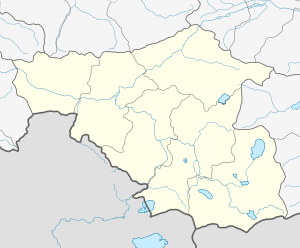Zarzma monastery
The Zarzma Monastery of Transfiguration (Georgian: ზარზმის მონასტერი, zarzmis p'erists'valebis monasteri) is a medieval Orthodox Christian monastery located at the village of Zarzma in Samtskhe-Javakheti region, southwest Georgia.
| Zarzma Monastery of Transfiguration Georgian: ზარზმის მონასტერი | |
|---|---|
-2.jpg) The monastic church of Transfiguration at Zarzma | |
| Religion | |
| Affiliation | Georgian Orthodox Church |
| Location | |
| Location | village of Zarzma in Samtskhe-Javakheti region, Georgia |
 Shown within Georgia  Zarzma monastery (Samtskhe-Javakheti) | |
| Geographic coordinates | 41°40′47″N 42°39′14″E |
| Architecture | |
| Type | Church |
| Completed | Church: 8th century, renovated 14th century. |
| Dome(s) | 1 |
The Zarzma monastery is nested in the forested river valley of Kvabliani in the Adigeni municipality, 30 km west of the city of Akhaltsikhe. It is the complex of a series of buildings dominated by a domed church and a belfry, one of the largest in Georgia.[1]
The earliest church on the site was probably built in the 8th century, by the monk Serapion whose life is related in the hagiographic novel by Basil of Zarzma. According to his source, the great nobleman Giorgi Chorchaneli made significant donation – including villages and estates – to the monastery. The extant edifice dates from the early years of the 14th century, however. Its construction was sponsored by Beka I, Prince of Samtskhe and Lord High Mandator of Georgia of the Jaqeli family. What has survived from the earlier monastery is the late 10th-century Georgian inscription inserted in the chapel's entrance arch. The inscription reports the military aid rendered by Georgian nobles to the Byzantine emperor Basil II against the rebellious general Bardas Sclerus in 979.[2] In 1544, the new patrons of the monastery – the Khursidze family – refurnished the monastery.
The façades of the church are richly decorated and the interior is frescoed. Apart from the religious cycles of the murals there are a series of portraits of the 14th-century Jaqeli family as well as of the historical figures of the 16th century. After the Ottoman conquest of the area later in the 16th century, the monastery was abandoned and lay in disrepair until the early 20th century, when it was reconstructed, but some of the unique characteristics of the design were lost in the process. [1]
Currently, the monastery is functional and houses a community of Georgian monks. It is also the site of pilgrimage and tourism.
A smaller replica of the Zarzma church, known as Akhali Zarzma ("New Zarzma") is located in the same municipality, near Abastumani. It was commissioned by Grand Duke George Alexandrovich, a member of the Russian imperial family, from the Tbilisi-based architect Otto Jacob Simons who built it between 1899 and 1902, marrying a medieval Georgian design with the contemporaneous architectural forms. Its interior was frescoed by the Russian painter Mikhail Nesterov.[3]
See also
- Chulevi monastery
- Sapara Monastery
References
- (in Georgian) Zakaraia, Parmen (1981), ქართული ცენტრალურ-გუმბათოვანი არქიტექტურა XI-XVIII სს. (Georgian centrally-planned domed architecture of the 11th-18th centuries). Tbilisi: pp. 56-88.
- Holmes, Catherine (2005), Basil II and the Governance of Empire (976-1025), p. 242. Oxford University Press, ISBN 0-19-927968-3.
- New Zarzma. Abastumani Tourism Association. Retrieved on July 2, 2009
External links
| Wikimedia Commons has media related to Zarzma monastery. |
- The Zarzma monastery website
- The Zarzma monastery, Parliament of Georgia website
- Adigeni.com The Guide to Adigeni and Zarzma